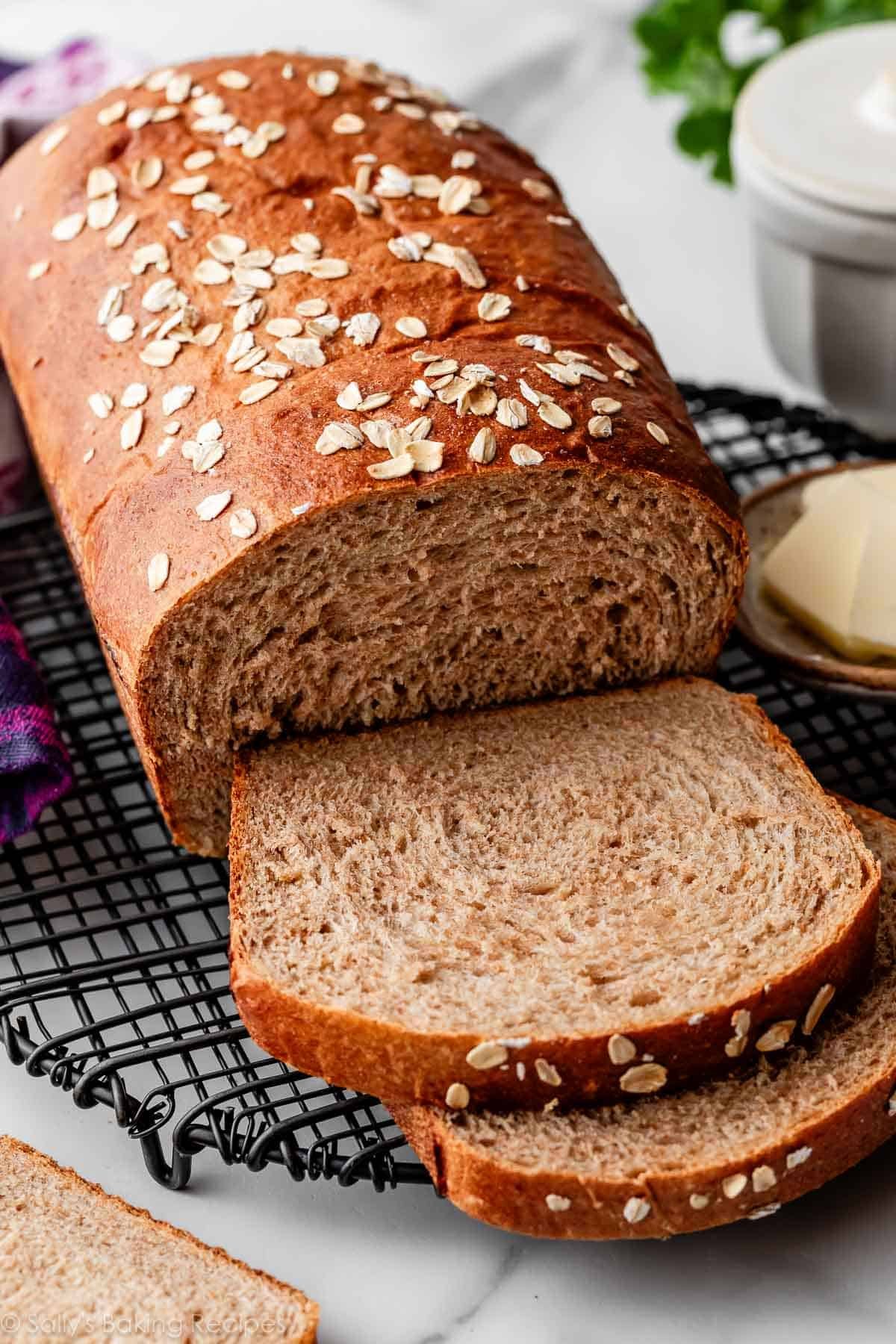Back to search results

Whole Wheat Bread
4.9 (1421 reviews)
You need just 8 simple ingredients to make this whole wheat sandwich bread. It's soft yet hearty and oh-so-flavorful, and store-bought sandwich bread just doesn't compare! You can use 100% whole wheat flour, or you can swap in some bread flour for a taller, fluffier loaf. See recipe Notes for freezing and overnight instructions. You can also reference my Baking with Yeast Guide for answers to common yeast FAQs.
Total Time310
Servings1
?
Caloriesper servingIngredients
Sponge
- 1 cup (240ml) water, warmed to about 110°F (43°C)
- 1/3 cup (80ml) whole milk, warmed to about 110°F (43°C)
- 2 and 1/4 teaspoons (7g) active dry or instant yeast (1 standard packet)
- 2 cups (260g) whole wheat flour (spooned & leveled)
Dough
- 3 Tablespoons (63g) honey
- 3 Tablespoons (43g) unsalted butter, softened to room temperature
- 1 teaspoon fresh lemon juice (or apple cider vinegar)
- 1 and 1/3 cups (173g) whole wheat flour (spooned & leveled), plus more as needed
- 1 and 1/4 teaspoons salt
- optional oat topping: 1 beaten egg white + 1 Tablespoon whole oats
Instructions
- 1Prepare the sponge
- 2In a large bowl or the bowl of your stand mixer, whisk the water, whole milk, and yeast together. Add the 2 cups (260g) flour and stir with a spatula or wooden spoon until a thick batter forms. Cover lightly and allow to double in size at room temperature, about 60–90 minutes. Sometimes this can take up to 2 hours. *I do not recommend a hand mixer for this dough because the dough is too thick and heavy.*
- 3Add the remaining dough ingredients including the honey, butter, lemon juice, remaining flour, and the salt. With a dough hook attachment, or using a spatula or wooden spoon (and some arm muscle!), beat on medium speed/mix until the dough comes together and pulls away from the sides of the bowl, about 3 minutes. If the dough seems too wet to a point where kneading (next step) would be impossible, beat in more flour 1 Tablespoon at a time until you have a workable dough, similar to the photos above. Dough should be soft and a little sticky, but still manageable to knead with lightly floured hands.
- 4Knead the dough
- 5Keep the dough in the mixer and beat for an additional 8–10 full minutes, or knead by hand on a lightly floured surface for 8–10 full minutes. (If you’re new to bread-baking, my How to Knead Dough video tutorial can help here.) If the dough becomes too sticky during the kneading process, add 1 more Tablespoon of flour at a time to make a soft, slightly tacky dough. Do not add more flour than you need; you do not want a dry dough. After kneading, the dough should still feel a little soft. Poke it with your finger—if it slowly bounces back, your dough is ready to rise.
- 61st rise
- 7Lightly grease a large bowl with oil or nonstick spray. Place the dough in the bowl, turning it to coat all sides in the oil. Cover the bowl and allow the dough to rise in a relatively warm environment for 1.5–2 hours or until about double in size. (For a tiny reduction in rise time, see my answer to Where Should Dough Rise? in my Baking With Yeast Guide.)
- 8Grease a 9×5-inch loaf pan.
- 9Shape the dough
- 10When the dough is ready, punch it down to release the air. Lightly flour a work surface, your hands, and a rolling pin. Roll the dough out into a large rectangle, about 8×15 inches. It does not have to be perfect—in fact, it will probably be rounded on the edges. That’s ok! Roll it up into an 8-inch log and place in the prepared loaf pan.
- 112nd rise
- 12Cover shaped loaf. Allow to rise until it’s about 1 inch above the top of the loaf pan, about 45–60 minutes.
- 13Adjust oven rack to a lower position and preheat oven to 350°F (177°C). It’s best to bake the bread towards the bottom of the oven so the top doesn’t burn.
- 14Optional oat topping: If you want to add the optional oat topping, add it right before baking the bread. With a pastry brush, brush the risen loaf with egg white, then sprinkle the oats on top.
- 15Bake the bread
- 16Bake for 36–40 minutes, or until golden brown on top. If you notice the top browning too quickly, loosely tent the pan with aluminum foil. (I usually add it around the 20-minute mark.) To test for doneness, if you gently tap on the loaf, it should sound hollow. For a more accurate test, the bread is done when an instant-read thermometer reads the center of the loaf as 195–200°F (90–93°C). Remove from the oven and allow bread to cool for a few minutes in the pan on a cooling rack before removing the bread from the pan and slicing. Feel free to let it cool completely before slicing, too.
- 17Cover leftover bread tightly and store at room temperature for up to 1 week.